Eduard 1/48 FW-190D-13
|
KIT #: |
8185 |
|
PRICE: |
$79.95 SRP
|
|
DECALS: |
Two options |
|
REVIEWER: |
Tom Cleaver |
|
NOTES: |
|
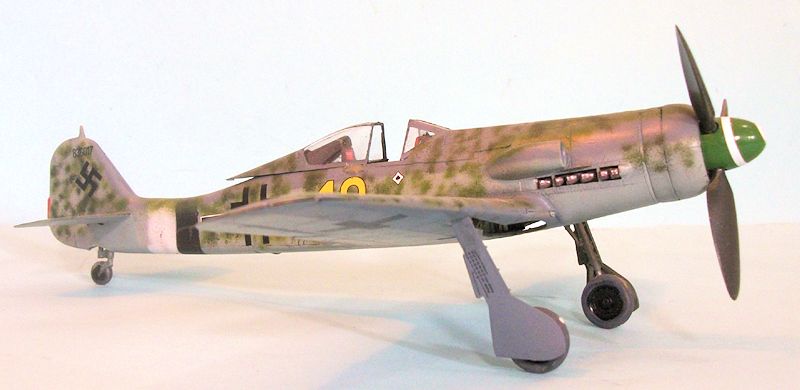
The “Dora” series of Kurt Tank’s Fw‑190 fighter first appeared on
operations in September 1944, initially equipping III/JG 54, which served at
Hesepe and Achmer as low‑level cover for the Me‑262s of Kommando Nowotny during
October‑November 1944.
The
aircraft differed from the previous radial engine fighters of the “Anton” series
by the replacement of the BMW 801 with the Jumo 213A inverted‑V‑12 liquid‑cooled
engine.
Externally, the nose was
lengthened 24 inches and a 19.5‑inch section was added immediately ahead of the
tail section, while the chord of the vertical fin was extended aft 5.5. inches
by moving the rudder post, increasing fin area by 2.5 sq. ft. to compensate for
increased side area of the extended fuselage.
Armament was reduced from four MG 151 20mm cannon and two MG 131 13mm
machine guns to two MG 131 in the cowling with 475 r.p.g. and two MG 151 in the
wing root with 250 r.p.g., all four weapons firing through the propeller.
The Jumo 213A‑1 engine was rated at 1,776 h.p. at takeoff, and 1,600 h.p.
at 6,000 meters altitude.
With MW
50 injection, power was increased to 2,240 h.p. at sea level, 2,000 h.p. at
3,000 meters, and 1,880 h.p. at 6,000 meters.
Unfortunately, power fell off above 8,000 meters, so the Dora‑9 was not
the solution to the altitude problem that had plagued the Fw‑190 from the
outset.
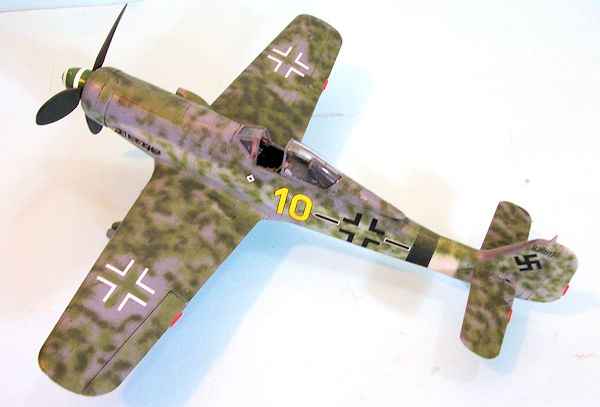 At
first, the Langnasen Dora as it was called, was viewed with suspicion by
the pilots of the Jadgwaffe, since the Jumo 213 was viewed as a bomber
engine forced on the fighter by the RLM; that Tank himself told the pilots the
Dora‑9 was only an “emergency solution” pending introduction of the Ta‑152 did
nothing to dispel this attitude. Once the pilots of III/JG 54 began operations
in defense of the jets, they discovered that the Dora‑9 could out‑climb and
out‑dive the radial‑powered Antons, as well as a speed increase that made the
airplane competitive with the Spitfire XIV, Tempest II and was more than a match
for the P‑51D Mustang. During six months’ combat from initial introduction to
the end of the war, flying with several of the Front Geschwadern
like JG
26 and JG 2, the Langnasen Dora would eventually be considered among the
best German fighters of the war; no less an expert than Chuck Yeager called it
the most impressive piston‑engine fighter he ever flew during post‑war
evaluation.
At
first, the Langnasen Dora as it was called, was viewed with suspicion by
the pilots of the Jadgwaffe, since the Jumo 213 was viewed as a bomber
engine forced on the fighter by the RLM; that Tank himself told the pilots the
Dora‑9 was only an “emergency solution” pending introduction of the Ta‑152 did
nothing to dispel this attitude. Once the pilots of III/JG 54 began operations
in defense of the jets, they discovered that the Dora‑9 could out‑climb and
out‑dive the radial‑powered Antons, as well as a speed increase that made the
airplane competitive with the Spitfire XIV, Tempest II and was more than a match
for the P‑51D Mustang. During six months’ combat from initial introduction to
the end of the war, flying with several of the Front Geschwadern
like JG
26 and JG 2, the Langnasen Dora would eventually be considered among the
best German fighters of the war; no less an expert than Chuck Yeager called it
the most impressive piston‑engine fighter he ever flew during post‑war
evaluation.
Further development of the aircraft resulted in the Fw‑190D‑11, which introduced
the Jumo 213F engine that also powered the Ta‑152H.
Armed with an additional 2 30mm MK 108 cannon in the outboard position as
a proposed Schlactflieger, only 7 prototypes were constructed, of which
only one ‑ the V61 ‑ was in an operational unit, the famous Parrot Staffel of JV
44.
The
final development of the type to see operational service was the Fw‑190D‑13,
which replaced the two fuselage‑mounted MG 131s with an MG 151 motorkanon, and
was powered by the Jumo 213EB.
Only
two prototypes were completed before the end of the war.
One was delivered to JG 26 in late March 1945, where it became the mount
of Major Franz Goetz, who had relieved “Pips” Priller as Kommodore on January
28, 1945.
A prewar enlisted pilot,
Goetz had worked his way up through the ranks and was a 63‑victory experte from
JG 53.
Goetz made no claims while
flying this airplane through the final month of the conflict.
“Yellow 10"
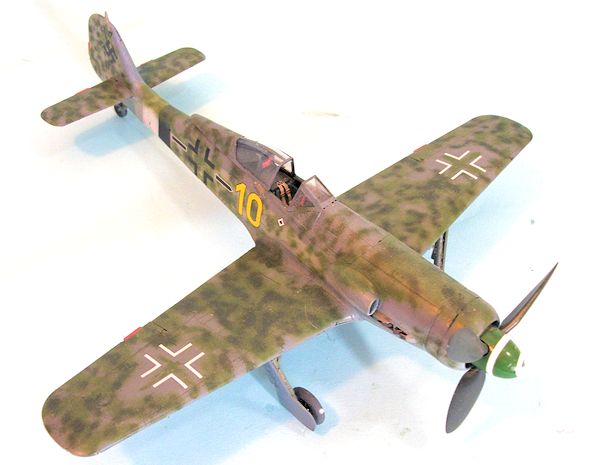 Interestingly, the one‑and‑only Fw‑190D‑13 to see service was one of several
Doras collected from JG 26 after the war and taken to the United States for
testing and evaluation at Wright‑Patterson Air Base.
After a desultory test program over the year following V‑E day, the
Dora‑13 ended up at Freeman Field Indiana, where it was chosen to partake as a
captured aircraft in a victory celebration on Air Force Day in Georgia.
At this moment, something strange happened: the wing of the Dora‑13 was
exchanged with that of a Dora‑9 on the field, for reasons no one has ever
explained.
Following its appearance
at the show, the Dora‑13 was left on the field.
At some point in the 1950s it was purchased and ended up in pieces in an
abandoned lot in Atlanta, where it was discovered in the late 1960s by aviation
historian Jerry Crandall.
In the
meantime, the Dora‑9 that had the Dora‑13 wing was taken back to
Wright‑Patterson, where it was restored for display at the Air Force Museum.
No one paid any attention to the wing difference.
Interestingly, the one‑and‑only Fw‑190D‑13 to see service was one of several
Doras collected from JG 26 after the war and taken to the United States for
testing and evaluation at Wright‑Patterson Air Base.
After a desultory test program over the year following V‑E day, the
Dora‑13 ended up at Freeman Field Indiana, where it was chosen to partake as a
captured aircraft in a victory celebration on Air Force Day in Georgia.
At this moment, something strange happened: the wing of the Dora‑13 was
exchanged with that of a Dora‑9 on the field, for reasons no one has ever
explained.
Following its appearance
at the show, the Dora‑13 was left on the field.
At some point in the 1950s it was purchased and ended up in pieces in an
abandoned lot in Atlanta, where it was discovered in the late 1960s by aviation
historian Jerry Crandall.
In the
meantime, the Dora‑9 that had the Dora‑13 wing was taken back to
Wright‑Patterson, where it was restored for display at the Air Force Museum.
No one paid any attention to the wing difference.
In
the 1970s, the Dora‑13 was acquired by Doug Champlin and rebuilt to be
operational, though it was never flown (a good thing, since many of the
hand‑made systems were not that good, and the likelihood is it would have
crashed on its first attempt at flight).
Information had been obtained about the airplane and it was marked as
Yellow 10, with the Gruppen Kommodore markings it had carried when flown
by Major Goetz.
In the early 1990s,
the swap of wings was discovered.
At the time there was nothing to be done about it, inasmuch as the Air Force was
uninterested in pulling their Dora out of display for a wing swap. (It is
interesting to note as an aside that when Tamiya measured the Air Force Museum
Dora in the early 1990s for their 1/48 Fw‑190D‑9 kit, they faithfully recreated
what they had seen, down to the incorrect wing with only the one shell ejection
chute in the wing center section.)
During this period, Jerry Crandall managed to obtain sufficient photos of Yellow
10 shortly after its capture in 1945 to confirm its paint scheme and markings.
Almost nothing in the restoration was right!
In fact, Yellow 10 had a camouflage paint scheme unlike anything else in
the Luftwaffe, an overall dark and light green dapple applied over the overall
RLM75 scheme it had been delivered in.
 Good things come to those who wait.
In 2003, the Air Force discovered they needed to overhaul their Fw‑190D because
of corrosion.
This would require
disassembly.
A swap of wings was
concluded, and Yellow 10 finally had the chance to be whole again after nearly
60 years in separate pieces. Since then, Yellow 10 has been stripped and
cleaned, with incorrect parts rebuilt for a more accurate look, and Jerry
Crandall supervised a repaint of the airframe following reassembly in early
2004.
Yellow 10 finally looks
mostly like it originally did in April 1945, though Jerry says it should have
been painted by modelers, since the colors are “slightly too harsh and too
hard.”
(There’s just no pleasing
some AMS sufferers, is there?)
Today, it is at the Seattle Museum of Flight for those who want to see it.
Good things come to those who wait.
In 2003, the Air Force discovered they needed to overhaul their Fw‑190D because
of corrosion.
This would require
disassembly.
A swap of wings was
concluded, and Yellow 10 finally had the chance to be whole again after nearly
60 years in separate pieces. Since then, Yellow 10 has been stripped and
cleaned, with incorrect parts rebuilt for a more accurate look, and Jerry
Crandall supervised a repaint of the airframe following reassembly in early
2004.
Yellow 10 finally looks
mostly like it originally did in April 1945, though Jerry says it should have
been painted by modelers, since the colors are “slightly too harsh and too
hard.”
(There’s just no pleasing
some AMS sufferers, is there?)
Today, it is at the Seattle Museum of Flight for those who want to see it.
Eduard brought out the Fw-190D-13 as part of their “compleat Fw-190"
series of kits.
It was released as
a “Double Combo” with sufficient parts to make the D-13 and the Fw-190D-11, with
decals for 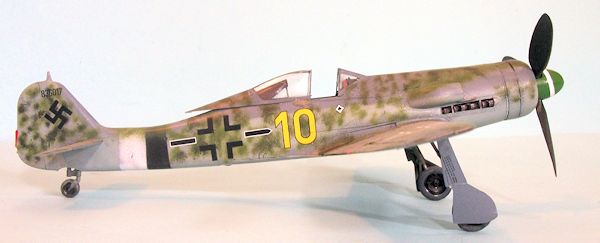 Yellow 10 and the three different markings known to have been on the
Fw-190D-11 including the Parrot Staffel.
Yellow 10 and the three different markings known to have been on the
Fw-190D-11 including the Parrot Staffel.
While the Eduard kits of the Antons have a well-deserved
reputation for being overly-fiddly, the Dora kits are less so - though
still the most fiddly Dora kits available.
In the case of the D-13 and D-11, Eduard released these with fuselages
that take into account the widening of the engine compartment as compared to the
Dora-9.
Thus it is the only
accurate kit of these versions other than the long-gone Wurger Mechanic resin
conversions from 12 years ago.
The one area of this kit that is still as fiddly as the Anton kits is the
upper wing and the cover for the inboard cannon.
It’s really designed to work posed open.
I wanted to close it and found that the only way I could get it to look
right was to sand down the cannon cover till it could be glued to the wing and
fit the 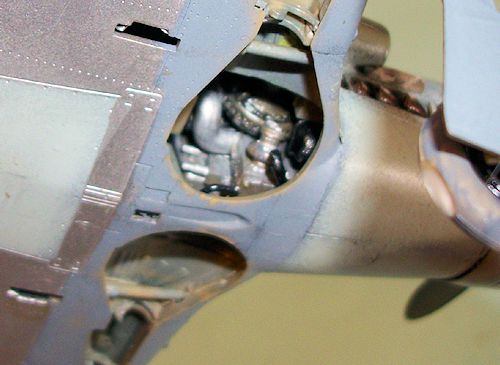 opening right.
The wing
with that cover one would only really fit to the fuselage if each upper wing
part was attached individually to the separate fuselage half so thatthe upper
part of the gun cover could be pressed into position correctly.
opening right.
The wing
with that cover one would only really fit to the fuselage if each upper wing
part was attached individually to the separate fuselage half so thatthe upper
part of the gun cover could be pressed into position correctly.
I then followed instructions and painted and assembled the cockpit and
the engine bay and wheel wells, using Xtracrylix RLM02 and RLM66, then glued
them in position, then glued the fuselage halves together, then glued the lower
wing to the upper wing parts.
This
way, fit was good enough I didn’t use filler on the model, only smoothing out
any excess glue once it has set.
I
then carefully attached the upper fuselage gun cover and attached the elevators
and the radiator assembly with cowling.
While that previous paragraph sounds simple, the kit is very fiddly and
it took a lot of effort to get parts to fit right before applying glue.
Be sure you have things in the right position before making that
permanent.
I first pre-shaded the model, then applied the black/white JG 26
Reichverteidigung stripes and masked that.
I painted the lower wing surface with Auto Air Aluminum over light grey
primer and then masked that.
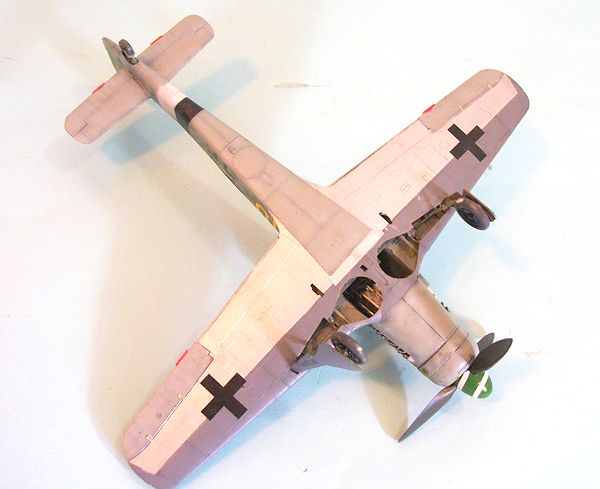 Eduard wants you to paint the Fw-190D-13 with natural metal lower wings,
RLM76 lower surfaces and RLM81 uppers before applying the field-applied
camouflage.
This is wrong.
Jerry Crandall’s instructions in the decal sheet for Yellow 10 are right:
the airplane came out of the factory in the late war Dora-9 finish of RLM75
upper surfaces overall and RLM-76 lower surfaces.
I used RLM81 Dark Olive Green and RLM82 Light Green for the upper surface
random camouflage, following the decal instructions from Eagle Editions, using
Xtracrylix colors for all these camouflage paints.
The spinner was painted Tamiya Bright Green and the prop blades were
painted Tamiya Black Green.
Eduard wants you to paint the Fw-190D-13 with natural metal lower wings,
RLM76 lower surfaces and RLM81 uppers before applying the field-applied
camouflage.
This is wrong.
Jerry Crandall’s instructions in the decal sheet for Yellow 10 are right:
the airplane came out of the factory in the late war Dora-9 finish of RLM75
upper surfaces overall and RLM-76 lower surfaces.
I used RLM81 Dark Olive Green and RLM82 Light Green for the upper surface
random camouflage, following the decal instructions from Eagle Editions, using
Xtracrylix colors for all these camouflage paints.
The spinner was painted Tamiya Bright Green and the prop blades were
painted Tamiya Black Green.
Having already used the Eagle Editions decals long ago on my Wurger
Mechanic model, I used the Eduard decals, which went on without problem.
I gave the model an overall coat of Xtracrylix Clear Flat varnish, then
attached the landing gear and prop, and posed the canopy in the open position.
I liked that Eduard provides the open canoy that squeezes narrow along
the bottom, as the real one did, rather than hanging over the cockpit sides as
all other Fw-190 kits do.
Since I
doubt the airplane was really flown all that much, given that it is shown very
clean in the photos in Jerry Crandall’s book, I left it alone at that point.
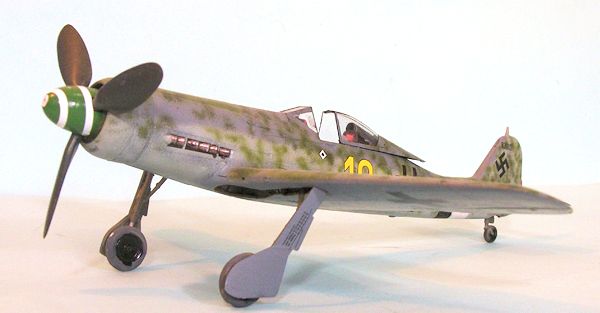 The Eduard Doras are the most detail-accurate of the available kits, and
the most fiddly.
Their D-11/D-13
kit is the only one of these two esoteric sub-types that is at all right. If
you’re a serious detail fanatic, these are the kits to get.
If you want a Dora kit that looks good, any of the others are less of a
hassle.
Recommended for those who
don’t mind fiddling.
The Eduard Doras are the most detail-accurate of the available kits, and
the most fiddly.
Their D-11/D-13
kit is the only one of these two esoteric sub-types that is at all right. If
you’re a serious detail fanatic, these are the kits to get.
If you want a Dora kit that looks good, any of the others are less of a
hassle.
Recommended for those who
don’t mind fiddling.
Tom Cleaver
July 2013
Review Kit Courtesy of Eduard.
If you would like your product reviewed fairly and fairly quickly, please
contact
the editor or see other details in the
Note to
Contributors.
Back to the Main Page
Back to the Review
Index Page



 Interestingly, the one‑and‑only Fw‑190D‑13 to see service was one of several
Doras collected from JG 26 after the war and taken to the United States for
testing and evaluation at Wright‑Patterson Air Base.
After a desultory test program over the year following V‑E day, the
Dora‑13 ended up at Freeman Field Indiana, where it was chosen to partake as a
captured aircraft in a victory celebration on Air Force Day in Georgia.
At this moment, something strange happened: the wing of the Dora‑13 was
exchanged with that of a Dora‑9 on the field, for reasons no one has ever
explained.
Following its appearance
at the show, the Dora‑13 was left on the field.
At some point in the 1950s it was purchased and ended up in pieces in an
abandoned lot in Atlanta, where it was discovered in the late 1960s by aviation
historian Jerry Crandall.
In the
meantime, the Dora‑9 that had the Dora‑13 wing was taken back to
Wright‑Patterson, where it was restored for display at the Air Force Museum.
No one paid any attention to the wing difference.
Interestingly, the one‑and‑only Fw‑190D‑13 to see service was one of several
Doras collected from JG 26 after the war and taken to the United States for
testing and evaluation at Wright‑Patterson Air Base.
After a desultory test program over the year following V‑E day, the
Dora‑13 ended up at Freeman Field Indiana, where it was chosen to partake as a
captured aircraft in a victory celebration on Air Force Day in Georgia.
At this moment, something strange happened: the wing of the Dora‑13 was
exchanged with that of a Dora‑9 on the field, for reasons no one has ever
explained.
Following its appearance
at the show, the Dora‑13 was left on the field.
At some point in the 1950s it was purchased and ended up in pieces in an
abandoned lot in Atlanta, where it was discovered in the late 1960s by aviation
historian Jerry Crandall.
In the
meantime, the Dora‑9 that had the Dora‑13 wing was taken back to
Wright‑Patterson, where it was restored for display at the Air Force Museum.
No one paid any attention to the wing difference.

 Yellow 10 and the three different markings known to have been on the
Fw-190D-11 including the Parrot Staffel.
Yellow 10 and the three different markings known to have been on the
Fw-190D-11 including the Parrot Staffel.
 opening right.
The wing
with that cover one would only really fit to the fuselage if each upper wing
part was attached individually to the separate fuselage half so thatthe upper
part of the gun cover could be pressed into position correctly.
opening right.
The wing
with that cover one would only really fit to the fuselage if each upper wing
part was attached individually to the separate fuselage half so thatthe upper
part of the gun cover could be pressed into position correctly.
